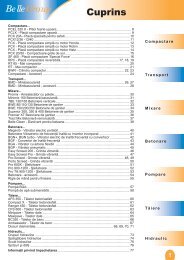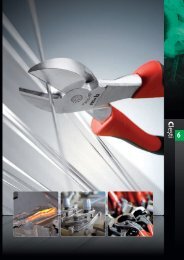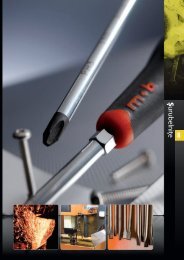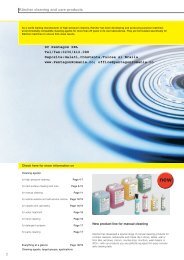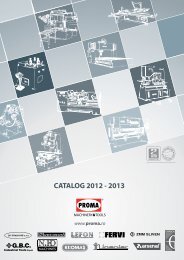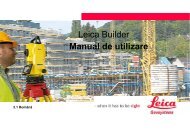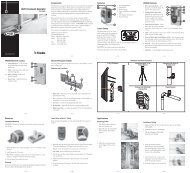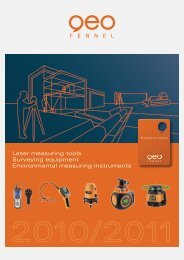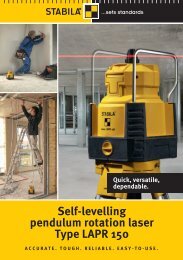powercoil.com.au wire thread insert system
powercoil.com.au wire thread insert system
powercoil.com.au wire thread insert system
Create successful ePaper yourself
Turn your PDF publications into a flip-book with our unique Google optimized e-Paper software.
®<br />
Manufactured from high quality chromium nickel stainless steel,<br />
PowerCoil Wire Thread Inserts provide high strength internal <strong>thread</strong>s<br />
that resist the effects of temperature and corrosion. Their unique<br />
design ensures superior <strong>thread</strong>s whose <strong>com</strong>pound performance cannot<br />
be reproduced by any other single fastening method. Available in two<br />
basic forms, free running or screw locking, they are much lighter and<br />
less expensive than any other equivalent type of <strong>thread</strong> <strong>insert</strong> and<br />
bec<strong>au</strong>se of their <strong>com</strong>pact size they can generally be incorporated into<br />
existing designs where no previous provision has been made.<br />
The high tensile coils of a <strong>wire</strong> <strong>thread</strong> <strong>insert</strong> undergo a diameter reduction during<br />
installation. The outward spring-like force of the coils “locks” the <strong>insert</strong> into place.<br />
Each coil can flex independently to contact the greatest amount of parent material<br />
<strong>thread</strong> surface.Both static and dynamic load bearing capabilities are improved.<br />
Standard Bolt<br />
Bolt with PowerCoil <strong>insert</strong><br />
Free Running<br />
Produced from precision profiled <strong>au</strong>stenitic stainless steel <strong>wire</strong> wound into a helical<br />
spiral, PowerCoil free running <strong>insert</strong>s have a spring like appearance.When installed,<br />
using any one of a variety of manual or <strong>au</strong>tomatic tools, they provide strong permanent<br />
internal <strong>thread</strong>s which resist heat and corrosion. Once fitted,their position is maintained<br />
by the action of radial pressure between their coils and the flanks of the tapped hole.<br />
This pressure exists bec<strong>au</strong>se their free diameter is larger by a calculated amount, than<br />
their installed diameter.<br />
50%<br />
25%<br />
12%<br />
6%<br />
3%<br />
2%<br />
30%<br />
22%<br />
17%<br />
13%<br />
10%<br />
8%<br />
Screw Locking<br />
Screw locking (or prevailing torque) <strong>insert</strong>s are of particular value in applications subject<br />
to the effects of cyclic vibration or impact. In addition to the benefits afforded by free<br />
running <strong>insert</strong>s, PowerCoil screw locking <strong>insert</strong>s offer the additional security of prevailing<br />
locking torque.This is achieved by the action of one or more polygonal grip coils<br />
positioned within the <strong>insert</strong>s l ength, which exert radial pressure on the male <strong>thread</strong>.<br />
Each grip coil consists of a number of tangential locking chords which protrude inside<br />
the minor diameter of the normal free running coils. As the male <strong>thread</strong> passes through<br />
these grip coils, the locking flats are displaced thus exerting radial pressure or<br />
prevailing torque on the male <strong>thread</strong>. On removal of the male <strong>thread</strong>,the locking coils<br />
relax to their original form permitting repeated assembly whilst retaining a measurable<br />
level of prevailing torque.<br />
Note It is re<strong>com</strong>mended that only close fit plated or lubricated bolts or screws<br />
are used with screw locking <strong>insert</strong>s.<br />
Features & Benefits<br />
For many years, helically coiled <strong>wire</strong> <strong>thread</strong> <strong>insert</strong>s have been vastly underestimated.<br />
The popular misconception that they were designed for the repair of damaged <strong>thread</strong>s<br />
has given this unique fastener a false image.<br />
They are much lighter and less expensive than any other equivalent type of <strong>thread</strong><br />
<strong>insert</strong> and bec<strong>au</strong>se of their <strong>com</strong>pact size,can generally be introduced into existing<br />
designs where no previous provision has been made. Unlike many other economic<br />
measures, their introduction increases quality and performance whilst reducing overall<br />
product cost. Their introduction may result in the use of thinner sections or lighter<br />
parent materials without sacrificing <strong>thread</strong> strength.<br />
They protect tapped <strong>thread</strong>s against failures due to stripping, seizing, corrosion and<br />
wear. PowerCoil <strong>wire</strong> <strong>thread</strong> <strong>insert</strong>s are produced from <strong>au</strong>stenitic stainless steel <strong>wire</strong><br />
which is work hardened to a tensile strength above 200,000psi and a hardness of<br />
Rc43-50.The <strong>insert</strong>s have an exceedingly smooth surface finish which virtually<br />
eliminates friction-induced <strong>thread</strong> errosion.<br />
The continuous helically coiled design negates the need for thick wall structures to<br />
support the internal and external <strong>thread</strong>s - the diamond profile <strong>wire</strong> coil IS the <strong>thread</strong>.<br />
PowerCoil <strong>wire</strong> <strong>thread</strong> <strong>insert</strong>s can be installed in rteduced size bosses or flanges and<br />
within constricted areas – saving space and weight while providing high strength.<br />
A boss radius equal to the nominal bolt diameter is usually sufficient.<br />
A <strong>com</strong>plete range of installation tools are available to suit specific production<br />
techniques. A range of hand tools exist for small runs and repairs; electric and<br />
pneumatic tools are available for high volume production requirements.<br />
Strength<br />
Due to their flexibility, <strong>wire</strong> <strong>thread</strong> <strong>insert</strong>s create internal <strong>thread</strong>s which have a much<br />
improved distribution of residual stress loading when <strong>com</strong>pared with conventional<br />
tapped holes, where up to 70% of the shearing forces are carried by the first three<br />
<strong>thread</strong>s in the tapped hole.The flexibility of <strong>wire</strong> <strong>thread</strong> <strong>insert</strong>s helps to <strong>com</strong>pensate<br />
for pitch and flank angle errors, inherent in normal tapped holes, and significantly<br />
enhances the load bearing capacity by deflecting the residual forces into a helical<br />
hoop stress which is dispersed into the wall of the tapped hole. This enables the<br />
design to be confidently based on the bolt strength utilising smaller and shorter<br />
<strong>thread</strong>s even when used in low strength materials.<br />
Eliminate Stress<br />
Virtually no stress is introduced into the parent material bec<strong>au</strong>se there is no staking,<br />
locking, swaging or keying in place.The outward “spring action” of the <strong>insert</strong> holds it<br />
in place.<br />
Wear Resistance<br />
The <strong>com</strong>bination of material hardness and the brilliant surface finish of <strong>wire</strong> <strong>thread</strong><br />
<strong>insert</strong>s creates internal <strong>thread</strong>s in which wear due to <strong>thread</strong> friction is virtually<br />
eliminated.This is of particular value in applications requiring repeated assembly &<br />
disassembly. The low frictional coefficient ensures that virtually all of the applied<br />
assembly torque is converted into clamping load. Thus providing <strong>thread</strong>s that stay tight.<br />
Corrosion Protection<br />
The 18/8 <strong>au</strong>stenitic stainless steel <strong>wire</strong> used in PowerCoil <strong>insert</strong>s resists corrosion<br />
under normal environmental conditions. Galvanic action within the <strong>thread</strong> assembly is<br />
reduced,increasing the life of the fastening assembly.<br />
Galvanic corrosion is most significant form of corrosion affecting <strong>insert</strong>s and fasteners.<br />
Galvanic corrosion occurs when dissimilar metals are in contact in the presence of an<br />
electrolytic solution. All metals exhibit different degrees of “activity” or “nobility” and can<br />
be arranged in a galvanic series of increasing activity. Gold and platinum are most noble<br />
while zinc and magnesium are most active.The most <strong>com</strong>mon electrolytic solution<br />
encountered is ordinary water. Seawater or salt spray is more damaging bec<strong>au</strong>se of high<br />
concentrations of dissolved salts.<br />
The best way to preclude galvanic corrosion is to use similar potential metals and<br />
eliminate the electrolyte conductor. The active stainless steel of PowerCoil <strong>wire</strong> <strong>thread</strong><br />
<strong>insert</strong>s are not passivated.This minimizes the possibility of galvanic corrosion<br />
occurring when they are installed in aluminum or magnesium parent materials.<br />
Some additional prec<strong>au</strong>tions for reducing galvanic corrosion are:<br />
1. Isolate the fasteners from the electrolyte.This can be done through gasketing or sealing.<br />
2. Specify cadmium plated <strong>insert</strong>s. The cadmium plate provides a sacrificial barrier<br />
against corrosion. In addition, the cadmium plate has lubricating properties that<br />
minimize galling when stainless steel screws are used.<br />
3. Apply corrosion inhibiting pastes or <strong>com</strong>pounds to the screw. These include zinc<br />
chromate primer (MIL-P-8585) and strontium chromate primer (MIL-P-23377). Note:<br />
Pastes applied to the CoilThread Insert can be<strong>com</strong>e trapped between the <strong>wire</strong> and<br />
the hole and c<strong>au</strong>se loss of proper tolerance.It is therefore re<strong>com</strong>mended to apply the<br />
paste only to the screw, not the <strong>insert</strong>. If zinc chromate primer is applied to the<br />
tapped hole it should be thinned and applied sparingly. The <strong>insert</strong> should be installed<br />
while the primer is still wet.<br />
4. Specify a dry film lubricant such as molybdenum disulphide on the <strong>insert</strong>s. This<br />
provides a secondary barrier against corrosion.<br />
5. Where practical or where it will not interfere with the <strong>com</strong>pleted assembly, the<br />
external joint should be coated with a suitable paint.<br />
®<br />
<strong>wire</strong> <strong>thread</strong> <strong>insert</strong> <strong>system</strong><br />
<strong>powercoil</strong>.<strong>com</strong>.<strong>au</strong>




